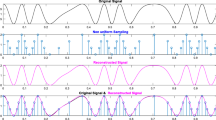Abstract
This paper presents a simple but practical method of mesh simplification and denoising of scanned data for styling design objects. In contrast to the existing studies on simplification, by employing the simplest classical primitive—contraction of each edge to its midpoint—the present method simultaneously simplifies and smoothes scanned data while maintaining the original design features. To extract the features from input meshes that include noise, this study develops a new curvature-based measure on the basis of the normal tensor theory. Furthermore, this study introduces a rectification process not only to form good triangles but also to prevent the generation of meshes with topological errors during simplification. Experimental results demonstrate that desirable meshes can be generated from real-world scanned data.


















Similar content being viewed by others
References
Abdelkader A, Mahmoud AH, Rushdi AA, Mitchell SA, Owens JD, Ebeida MS (2017) A constrained resampling strategy for mesh improvement. Comput Gr Forum 36(5):189–201. https://doi.org/10.1111/cgf.13256
Blinn JF (1978) Simulation of wrinkled surfaces. SIGGRAPH ’78. Comput Gr 12(3):286–292. https://doi.org/10.1145/965139.507101
Boubekeur T, Alexa M (2009) Mesh simplification by stochastic sampling and topological clustering. Comput Gr 33(3):241–249. https://doi.org/10.1016/j.cag.2009.03.025
Cabiddu D, Attene M (2015) Large mesh simplification for distributed environments. Comput Gr 51:81–89. https://doi.org/10.1016/j.cag.2015.05.015
Cignoni P, Rocchini C, Scopigno R (1998) Metro: measuring error on simplified surfaces. Comput Gr Forum. https://doi.org/10.1111/1467-8659.00236
Fleishman S, Cohen-Or D, Silva CT (2005) Robust moving least-squares fitting with sharp features. ACM Trans Gr (Proc ACM SIGGRAPH 2005) 24(3):544–552. https://doi.org/10.1145/1073204.1073227
Fleishman S, Drori I, Cohen-Or D (2003) Bilateral mesh denoising. ACM Trans Gr (Proc ACM SIGGRAPH 2003) 22(3):950–953. https://doi.org/10.1145/882262.882368
Frey WH, Field DA (1991) Mesh relaxation: a new technique for improving triangulations. Int J Numer Methods Eng 31(6):1121–1133. https://doi.org/10.1002/nme.1620310607
Garland M, Heckbert PS (1997) Surface simplification using quadric error metrics. In: SIGGRAPH ’97 Proceedings of the 24th annual conference on Computer graphics and interactive techniques pp. 209–216. https://doi.org/10.1145/258734.258849
Heckbert PS, Garland M (1999) Optimal triangulation and quadric-based surface simplification. Comput Geom 14:49–65. https://doi.org/10.1016/S0925-7721(99)00030-9
Hoppe H (1998) Efficient implementation of progressive meshes. Comput Gr 22(1):27–36. https://doi.org/10.1016/S0097-8493(97)00081-2
Jones TR, Durand F, Desbrun M (2003) Non-iterative, feature-preserving mesh smoothing. ACM Trans Gr Proc ACM SIGGRAPH 2003 22(3):943–949. https://doi.org/10.1145/882262.882367
Kim SJ, Kim CH, Levin D (2002) Surface simplification using a discrete curvature norm. Comput Gr 26(5):657–663. https://doi.org/10.1016/S0097-8493(02)00121-8
Liu S, Ferguson Z, Jacobson A, Gingold Y (2017) Seamless: Seam erasure and seam-aware decoupling of shape from mesh resolution. ACM Trans Gr 36(6):216:1–216:15. https://doi.org/10.1145/3130800.3130897
Lo SH (1989) Generating quadrilateral elements on plane and over curved surfaces. Comput Struct 31(3):421–426. https://doi.org/10.1016/0045-7949(89)90389-1
Lu X, Chen W, Schaefer S (2017) Robust mesh denoising via vertex pre-filtering and l1-median normal filtering. Comput Aid Geom Des 54:49–60. https://doi.org/10.1016/j.cagd.2017.02.011
Medioni G, Lee MS, Tang CK (2000) A computatinal framework for segmentaion and grouping. Elsevier, Amsterdam
MeshImp. https://github.com/Ahdhn/MeshImp/blob/master/README.md. Accessed 5 Oct 2018
MeshLab: http://www.meshlab.net/. Accessed 5 Oct 2018
Metro: https://sourceforge.net/projects/vcg/files/metro/. Accessed 5 Oct 2018
Page DL, Koschan A, Sun Y, Paik J, Abidi MA (2001) Robust crease detection and curvature estimation of piecewise smooth surfaces from triangle mesh approximations using normal voting. Proc Int Conf Comput Vis Pattern Recognit 1:162–167. https://doi.org/10.1109/CVPR.2001.990471
Rhinoceros. https://www.rhino3d.com/. Accessed 5 Oct 2018
SeamAwareDecimater. https://github.com/songrun/SeamAwareDecimater/blob/master/README.md. Accessed 5 Oct 2018
Tang H, Shu H, Dillenseger J, Bao X, Luo L (2007) Moment-based metrics for mesh simplification. Comput Gr 31(5):710–718. https://doi.org/10.1016/j.cag.2007.05.001
Tsuchie S (2017) Reconstruction of underlying surfaces from scanned data using line of curvature. Comput Gr 68:108–118. https://doi.org/10.1016/j.cag.2017.08.015
Tsuchie S, Higashi M (2012) Surface mesh denoising with normal tensor framework. Gr Models 74(4):130–139. https://doi.org/10.1016/j.gmod.2012.03.010
Wang D, Hassan O, Morgan K, Weatherill N (2007) Enhanced remeshing from STL files with applications to surface grid generation. Commun Numer Methods Eng 23:227–239. https://doi.org/10.1002/cnm.894
Wei Y, Wu L, Sun B, Zhu X (2014) Improved QEM simplification algorithm based on discrete curvature and a sparseness coefficient. In: 2014 international conference on IT convergence and security (ICITCS), pp 1–5. https://doi.org/10.1109/ICITCS.2014.7021780
Yan X, Lou Y, Li L (2017) The triangle collapse algorithm based on angle error metrics. Springer, Singapore, pp 621–632. https://doi.org/10.1007/978-981-10-6385-5_52
Acknowledgements
Blade model (Data 5) is courtesy of the AIM@SHAPE Shape Repository.
Author information
Authors and Affiliations
Corresponding author
Additional information
Publisher’s Note
Springer Nature remains neutral with regard to jurisdictional claims in published maps and institutional affiliations.
Rights and permissions
About this article
Cite this article
Tsuchie, S. Mesh simplification accompanied by its denoising of scanned data. Engineering with Computers 35, 993–1008 (2019). https://doi.org/10.1007/s00366-018-0647-x
Received:
Accepted:
Published:
Issue Date:
DOI: https://doi.org/10.1007/s00366-018-0647-x




